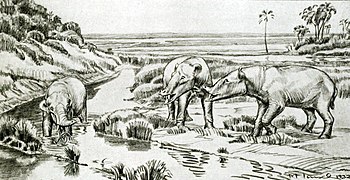Phiomia

| Phiomia | |
|---|---|
 | |
| P. serridens skull from Faiyum, Egypt, with 20th century plaster model. | |
| Scientific classification | |
| Domain: | Eukaryota |
| Kingdom: | Animalia |
| Phylum: | Chordata |
| Class: | Mammalia |
| Order: | Proboscidea |
| Suborder: | Elephantiformes |
| Family: | †Phiomiidae |
| Genus: | †Phiomia Andrews and Beadnell, 1902 |
| Species | |
| |
Phiomia is an extinct genus of basal elephantiform proboscidean that lived in what is now Northern Africa during the Late Eocene to Early Oligocene some 37–30 million years ago.[1] "Phiomia serridens" means "saw-toothed animal of Faiyum".
Description
[edit]Phiomia serridens (=P. wintoni, P. osborni, P. minor[2]) is estimated to have had a shoulder height 134.5 centimetres (4.41 ft),[3] while P. major was larger.[2] It vaguely resembled a modern elephant, although, based on the shape of its nasal bones, it had only a very short trunk. It had short tusks on the upper jaw and also short shovel-like tusks on the lower jaw that were most likely used for gathering food. These were similar to those of the Miocene Platybelodon, Archaeobelodon, and Amebelodon, but considerably smaller. The tusks in the upper jaw may have been used in defence,[4] or scraping bark off trees.
- 2016 reconstruction.
- 1932 illustration.
- Phiomia serridens (=P. minor) skull and model
- Phiomia model reconstruction at the Natural History Museum, London
References
[edit]- ^ Strauss, B. Prehistoric Elephant Pictures and Profiles
- ^ a b Werdelin, Lars; Sanders, William Joseph (2010-07-20). Cenozoic Mammals of Africa. Univ of California Press. ISBN 978-0-520-25721-4.
- ^ Osborn, Henry Fairfield; Percy, Mabel Rice (1936). Proboscidea : a monograph of the discovery, evolution, migration and extinction of the mastodonts and elephants of the world. Vol. 1. New York: Published on the J. Pierpont Morgan Fund by the trustees of the American Museum of Natural History.
- ^ Palmer, D., ed. (1999). The Marshall Illustrated Encyclopedia of Dinosaurs and Prehistoric Animals. London: Marshall Editions. p. 239. ISBN 1-84028-152-9.






